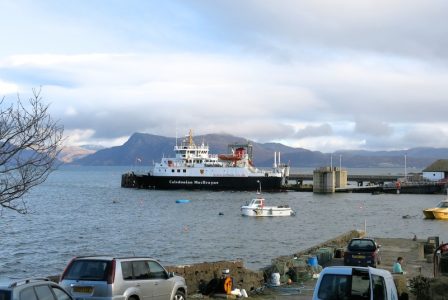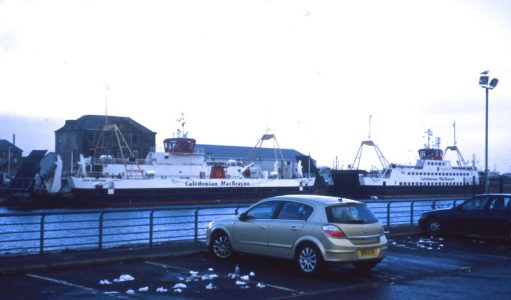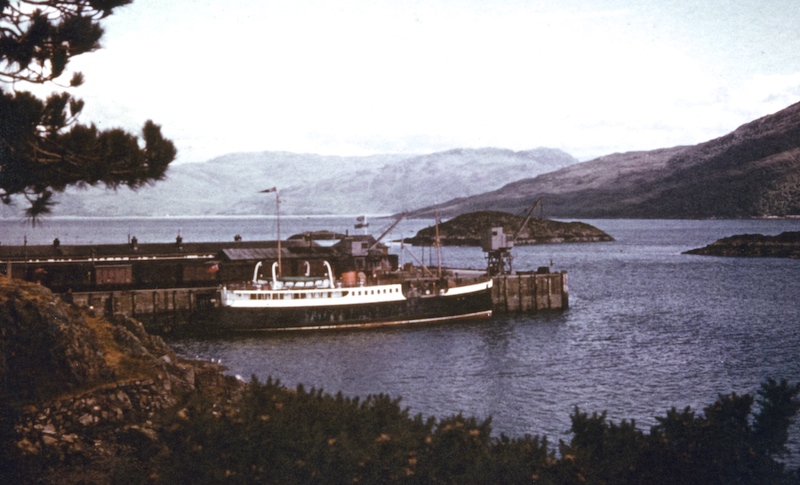
MacBrayne’s Loch Eynort and Loch Seaforth at Mallaig c1970: neither visited the loch after which they were named. Copyright CRSC Archive Collection
As speculation mounts over the choice of name for the new Uig triangle ferry, with Lochmor among the favourites, Colin Tucker asks whether the naming of ships after Scottish lochs has a logic to it, or is simply a matter of convenience.
Over the years a considerable number of the ships of David MacBrayne and CalMac have been named after Scottish lochs, no fewer than 31 being used. During a wet winter evening I took to considering how many of these ships could and did sail across their ‘own’ lochs, and how many would have found this impossible.
It is surprising just how few ships have actually sailed on the lochs after which they were named. Of those that did, the most obvious was Lochfyne of 1931, which for many years graced the loch of that name on her daily sails to Tarbert and Ardrishaig. But has the present ship of that name (incidentally now written as two words, Loch Fyne) ever visited these parts?

The 1931 Lochfyne, pictured leaving Ardrishaig in July 1967, was a regular visitor to Loch Fyne throughout her 39-year career. Copyright C. Kennedy Mills
The first Lochbroom would have called at Ullapool on her West Highland cruises during the 1930s and thus would have sailed up her namesake; it is unlikely that the second vessel of that name would have called there.
There were three ships named Lochness. Of these the first two were given that name when they were transferred to sail on the loch; the third, launched in 1929 to serve Stornoway, was clearly too large to enter the canal.
It might be expected that the ‘Loch’ class ferries introduced in the 1980s and 1990s would all have direct links, but in fact only four can make this claim. Loch Alainn, built for the Fishnish-Lochaline crossing, had a disastrous debut there in 1997 and was subsequently transferred elsewhere, but she must have entered the loch a good number of times for no other reason than to access the slipway.
Loch Ranza started service in 1986 as the Lochranza-Claonaig ferry and tied up every night at a buoy in the bay. Loch Tarbert has operated the Tarbert-Portavadie service and therefore at least sailed on East Loch Tarbert, if not West Loch Tarbert. Loch Linnhe has on various occasions undertaken the Oban-Lismore service, thereby making regular crossings of Loch Linnhe.
Only two of MacBrayne’s ships which sailed on inland waters were named after the lochs they sailed on. These were Lochawe and Loch Shiel. The latter was the second ship of that name; her predecessor was a cargo ship built in 1929 – there was no way she could have reached Loch Shiel.
The only other vessel to join this group is Loch Toscaig, which started her MacBrayne career on the Applecross service from Kyle of Lochalsh, making a daily trip down and up Loch Toscaig.

Lochnevis regularly sails past Loch Nevis (in the distance on the left) on her winter sailings to Armadale. Copyright CRSC Archive Collection
It might also be acceptable to include the second and third Lochalsh. Strictly speaking their short crossing was over Kyle Akin, but the division between that and Loch Alsh is far from finite and with a particular wind and tide both would probably have crossed on the latter stretch of water.
Three ships which might have sailed ‘on home waters’ are Loch Aline (ex Plover) and the two ships named Lochnevis. The former would have passed the entrance to Loch Aline many times en route from Oban to the Outer Isles. Both the other ships sailed regularly out of Mallaig and it must be thought that they would have at least poked their bows into Loch Nevis on some occasion.
The next category of ships contains those which could have sailed on their own lochs but never did so. None of the four vessels named Lochiel ever reached that stretch of water, although the first would have been close when she entered or left the Caledonian Canal at Corpach, and the last gave excursions to Fort William when based at Oban in 1939, her first season. Perhaps they would not have counted, as for some reason the ships’ names were all spelt differently from that of the loch – or is this being too pedantic? The first Lochbuie was probably the only MacBrayne vessel to sail on Loch Eil when she operated cruises there from Fort William before the Second World War.
The two Loch Seaforths could have entered the long fjord-like inlet that marks the boundary between Lewis and Harris, but neither has ever done so. Loch Eynort was named after a sea loch on the west side of Skye; although she was the Portree mail ship, there is no reason for her to have sailed on the other coast of Skye — or, for that matter, on the east side of South Uist, where there is another loch of the same name.

Loch Dunvegan and Loch Fyne in James Watt Dock, Greenock: their names show welcome respect for MacBrayne tradition but have nothing to do with route allocation. Copyright Walter Bowie
Similarly the two cargo ships named Lochdunvegan would have had no reason to sail up the west side of Skye on their way from Glasgow to Stornoway, although MacBrayne did operate a service to Dunvegan in earlier days. The third Loch Dunvegan, like her sister Loch Fyne written as two words, will not have seen her ‘home’ loch, in spite of starting her service carrying cars to Skye. Loch Carron saw steamers in the latter part of the 19th century when Strome Ferry was the railhead, but sailings there had been withdrawn long before the cargo boat Loch Carron was making her weekly trips round the islands.
Neither of the two small motor vessels named Lochbuie would have been seen in the sea loch of that name on the south coast of Mull. They could have been there had they undertaken the Six Lochs Cruise from Oban, for many years the preserve of King George V.
The present Loch Buie is also unlikely to have visited her ‘home’ loch, unless she had to seek shelter there when travelling south for overhaul from her Iona route.
Of the more recent car ferries both Loch Riddon and Loch Striven would have had no reason to enter the two inlets on the Clyde. Equally it would be hard to imagine why Loch Portain would have been seen on the loch of that name, unless she had been blown badly off course trying to reach Lochmaddy.

It is unlikely that Loch Buie has ever taken refuge in her ‘home’ loch on the south-east coast of Mull. She is pictured in the Caledonian Canal in 1992 during her delivery voyage to Iona from her builders at St Monans, Fife. Copyright Roddy MacLennan
The final category of ‘Loch’ ships comprises those which could never have sailed on their own lochs, for the simple reason that they were named after inland waters. There are no fewer than 10 such lochs, some large, some little more than blue dots on a map; we can only wonder why some were chosen as names for ships.
Lochs Ard, Arkaig, Earn, Garry (two of them) and Shira are all on the Scottish mainland. Loch Frisa is a small stretch of water on Mull and Loch Gorm is to be found on Islay. Loch Nell is a tiny land-locked loch to the east of Oban.
Loch Bhrusda lies on the island of Berneray, which thus has a close link with Loch Bhrusda’s original Sound of Harris route. There are two lochs called Loch Mor — one near Neist Point in Skye and another in North Harris — and a third spelt Loch More in Sutherland. All are inland. The case of Lochinvar is slightly different. Although the ship is named after Sir Walter Scott’s hero, his origin lies in a small loch of that name in Galloway.
This leaves one vessel that does not fit any of these groups. Lochailort sailed on the inland waters of Loch Shiel, but was named after a sea loch, admittedly one which is close to Loch Shiel.
It is amazing what interest and pleasure can be obtained from ship’s names.

Loch Riddon, pictured at Largs on 22 August 2014, has never been known to sail into the inlet off the Kyles of Bute after which she was named. Copyright CRSC Archive Collection

There have been two West Highland vessels named Lochmor — one of which, the 1930 MacBrayne vessel, is pictured at Kyle of Lochalsh on 29 June 1957. Known throughout the Outer Isles for more than 30 years, she never sailed on Loch Mor because all the lochs of that name are landlocked. Copyright CRSC Archive Collection
Colin Tucker is the speaker at the first meeting of CRSC’s 2017-18 winter session on October 11 at Jurys Inn, Glasgow. The title of his illustrated talk is ‘A decade of change — MacBraynes in the 1960s’.
Also by Colin Tucker: Crossing the Minch — Variations on a Theme
Colin Tucker’s widely admired book Steamers to Stornoway is available in the CRSC Shop.
Catch up with all CRSC’s posts at News & Reports











